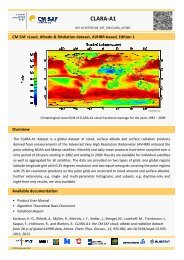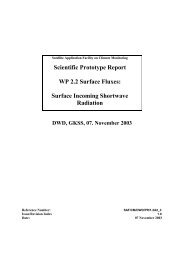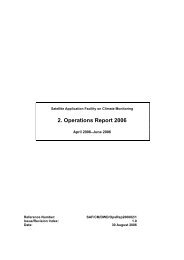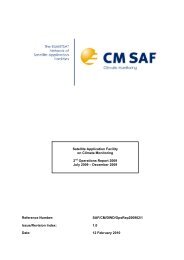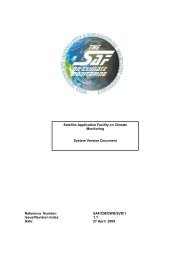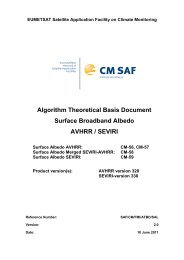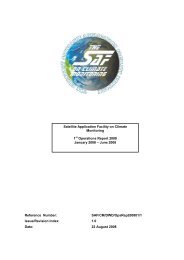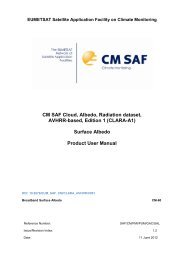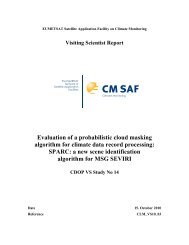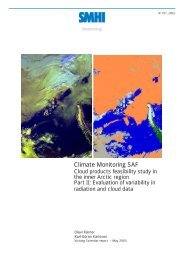Aerosol retrievals from METEOSAT-8 - CM SAF
Aerosol retrievals from METEOSAT-8 - CM SAF
Aerosol retrievals from METEOSAT-8 - CM SAF
You also want an ePaper? Increase the reach of your titles
YUMPU automatically turns print PDFs into web optimized ePapers that Google loves.
<strong>SAF</strong> on Climate Monitoring Visiting Scientists Report Doc. No: 1.0<br />
Issue : 1.0<br />
Date : 4 October 2006<br />
<strong>retrievals</strong> <strong>from</strong> SEVIRI there was limited time to elaborate a complete and robust algorithm. The<br />
feasibility of MSG/SEVIRI for <strong>retrievals</strong> of aerosol properties over land could be demonstrated, but<br />
with a lot of assumption that could have been avoided if more time would have been available.<br />
We used a simple cloud mask. The algorithm can then be upgraded and improved by using high<br />
performance cloud mask <strong>from</strong> the <strong>CM</strong>-<strong>SAF</strong> or NWC<strong>SAF</strong>. For the reference surface reflectance<br />
map, the cloud mask should include the detection of neighboured cloudy pixels (i.e. cloud free pixel<br />
near cloudy pixels) to exclude effects due to cloud borders. In future algorithm developments it is<br />
preferable to use the official cloud mask and to include a morphological mask that removes<br />
shadowed pixels that have lower reflectances than the surface. In appendix A the results for the<br />
northern part of the disc, as observed by MSG, are given using a more restrictive cloud mask. We<br />
only used one aerosol model: a continental model used in MERIS LUT's. It would be interesting to<br />
use appropriate model just based on simple climatology: desert dust over Africa, maritime model<br />
over ocean and burning biomass over Amazonia. As presented in the next section called “future<br />
improvements”, the use of others channels (0.865 µm and 1.650 µm) should be researched to get<br />
information on the spectral dependence of aerosols and an index of the size distribution which will<br />
be an indicator of the aerosol type.<br />
We used the single scattering assumption to simplify the calculations and to avoid use of LUT's,<br />
which could not be prepared due to the limited time available for this “visiting scientist” activity. Of<br />
course it is a source of uncertainty and systematic bias. Neglecting multiple scattering in the<br />
atmosphere is a strong assumption, especially when large amount of aerosols occurs and in the case<br />
of large solar-viewing zenith angles. This point can be easily solved by using Look Up Tables<br />
computed with an accurate radiative transfer model. The limitation is that a lambertian surface has<br />
to be assumed in those computations. However it is possible to correct for bidirectional effects<br />
when one knows the shape of the BRDF (Vermote et al. 1997, Ramon et al. 2001), which can be<br />
partly measured by SEVIRI. So an iterative approach seems possible here.<br />
7 Conclusions and perspectives<br />
SEVIRI is a powerful instrument for monitoring rapidly changing parameters of the atmosphere,<br />
and tropospheric aerosols fall into this category (see Appendix B for forest fires in Portugal in July<br />
2005). The survey of user requirements showed the need for an aerosol product <strong>from</strong> MSG/SEVIRI<br />
- 32 -



